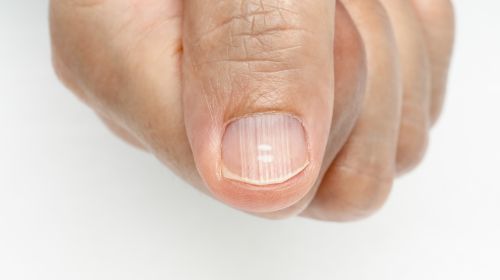Various varnishes are available for the treatment of nail fungus. Find out here what you need to consider when using antifungal agents and why you should avoid cosmetic nail polish during treatment.
Quick overview: Frequently asked questions and answers
Which varnish for nail fungus? Tried and tested nail polishes contain the active ingredients ciclopirox or amorolfine. Depending on the product, there are differences in the exact application.
Can you paint your nails despite nail fungus? Certain antifungal varnishes allow decorative nail polish to be used at the same time. The exact instructions on the package insert should be followed.
Article content at a glance:
Fight nail fungus effectively with polish
In most cases, the trigger for nail fungus (onychomycosis) is filamentous fungi (dermatophytes), which feel particularly comfortable in warm, moist areas of the skin. The fungus usually affects the toenails, but the fingernails can also be affected.
For the external treatment of nail fungus, varnishes as well as ointments and creams are available from the pharmacy. They contain fungicidal active ingredients such as amorolfine or ciclopirox.
If the infection is severe, a doctor may prescribe tablets for treatment. They are also indicated if the disease tends to originate in the nail root. If more than a third of the nail plate is affected, nail polish is often no longer sufficient to apply.
External therapy with varnish or cream requires a lot of patience from those affected and is not completed in a few days or weeks. In the case of toenail fungus, it takes several months until the pathogens are completely destroyed.
It is better to seek medical advice early
Nail fungus often initially affects the edges of the nail. Gradually, the pathogen eventually spreads to the entire nail plate. Discoloration, bumps and thickening of the nail are typical. The affected part of the nail can also detach from the nail bed.
In many cases, a fungal nail infection affects multiple toes. The fungi can also affect other areas of the skin such as the skin of the feet and cause athlete’s foot.
Many people overlook the first symptoms of nail fungus and/or put off visiting a doctor. However, nail fungus should be diagnosed and treated as early as possible.
Since the risk of infection with nail fungus is very high, certain preventative measures should be taken to ensure that other people do not become infected.
Application of varnish against nail fungus
Antifungal nail polishes against nail fungus generally contain either the active ingredient amorolfine or ciclopirox. In both cases, the antifungal agents intervene in the growth processes of the fungal cells and kill them. The products can also improve the appearance of the nails. The exact duration of treatment always depends on the severity of the infection.
However, there are some differences to consider when it comes to the application and effectiveness of the paints.
Ciclopirox: active ingredient against nail fungus
Ciclopirox is available in the form of water-soluble and water-insoluble varnishes.
Water-soluble products against nail fungus are applied once daily to the affected nail and the skin surrounding the edge of the nail using an applicator. Most manufacturers recommend using the antifungal before bedtime. Any paint residue should be washed off the next morning.
The dosage regimen for waterproof nail polishes is more complicated and may vary depending on the product. An example:
- first month: every other day
- second month: twice a week
- from the third month: once a week
With water-insoluble nail polishes, affected nail material must first be removed with a file. Care and caution should be taken when filing as the nail residue is very contagious. Disposable files should be used and should be disposed of after use.
The entire layer of paint must also be removed once a week with an alcohol swab. The exact instructions can be found in the package insert.
Nail polish with amorolfine for fungal infections
Fungicidal agents with the active ingredient amorolfine are waterproof and, due to their long-term effect, only need to be applied to the nail plate once or twice a week.
Before the first application, diseased nail areas must be removed with a disposable file. For all further applications, file again as necessary (e.g. if the nails are thickened).
Before each reapplication, the nail surface must be cleaned with an alcohol swab to remove any remaining polish.
After the medication has dried for about ten minutes, cosmetic nail polish can be applied. Before the next application with an antifungal agent, any existing decorative nail polish must be completely removed with nail polish remover. Important: You should not use nail polish remover in the meantime to avoid putting too much strain on your nails.
Cosmetic nail polishes against nail fungus?
Many sufferers do not want to do without colored nails during nail fungus treatment. Especially in summer, when you no longer want to hide your feet in shoes, it is tempting to simply paint over unsightly discolorations with nail polish.
There are some antifungal nail polishes that basically make this wish possible. However, you should use colored polishes to a lesser extent and avoid artificial nails altogether. There are several reasons for this:
Delayed healing: Colored varnishes or artificial nails make the natural nail impermeable to air. This can delay the healing process because the more oxygen that can reach the nail, the faster the disease disappears.
Stress on the nails: Artificial nails can damage natural nails, making them soft and brittle. Regular painting and the associated use of aggressive nail polish removers also dry out the nail surface and further reduce its resistance.
Danger to healthy nails: If you want to use artificial nails despite nail fungus, there is a risk that fungi will multiply in the smallest adhesive bubbles. When detaching, it can happen that parts of your own nail are torn off. There is also the risk that the polish brush will transfer the fungal pathogens from diseased nails to healthy ones.

